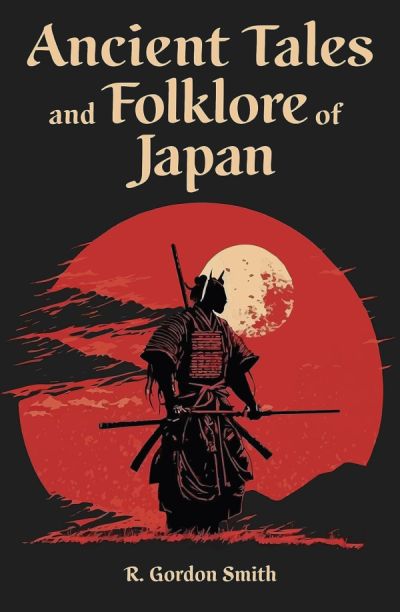Japanese Folklore

Ancient Tales and Folk-lore of Japan
Japanese folklore are heavily influenced by the two primary religions of Japan, Shinto and Buddhism. Japanese mythology is a complex system of beliefs that also embraces Shinto and Buddhist traditions as well as agriculture-based folk religion. The Shinto pantheon alone boasts an uncountable number of kami (deities or spirits). One notable aspect of Japanese mythology is that it provided a creation story for Japan and attributed divine origins to the Japanese Imperial family, assigning them godhood. The Japanese word for the Emperor of Japan, tennō (天皇), means "heavenly emperor."
Ancient Tales and Folk-lore of Japan, by Richard Gordon Smith, [1918]
The stories in this volume are transcribed from voluminous illustrated diaries which have been kept by me for some twenty years spent in travel and in sport in many lands--the last nine of them almost entirely in Japan, while collecting subjects of natural history for the British Museum; trawling and dredging in the Inland Sea, sometimes with success, sometimes without, but in the end contributing to the treasury some fifty things new to Science, and, according to Sir Edwin Ray Lankester, 'adding greatly to the knowledge of Japanese Ethnology.' As may be supposed, such a life has brought me into close contact with the people--the fisher, the farmer, the priest, the doctor, the children, and all others from whom there is a possibility of extracting information. Many and weird are the tales I have been told. In this volume the Publishers prefer to have a mixture--stories of Mountains, of Trees, of Flowers, of Places in History, and Legends. For the general results obtained in my diaries I have to thank our late Minister in Tokio, Sir Ernest Satow; the Ministers and Vice-Ministers of Foreign Affairs and of Agriculture, who gave me many letters of introduction; my dear friend Mr. Hattori, Governor of Hiogo Prefecture; the translators of the original notes and manuscripts (often roughly written in Japanese), among whom are Mr. Ando, Mr. Matsuzaki, and Mr. Watanabe; and Mr. Mo-No-Yuki, who drew and painted the illustrations from sketches of my own, which must often have grated on his artistic ideas, keeping him awake in reflection on the crudeness of the European sense of art. To my faithful interpreter Yuki Egawa also are due my thanks for continual efforts to find what I wanted; and to many Japanese peasants and fishermen, whose good-nature, kindness, and hospitality have endeared them to me forever. Well is it that they, so worthy a people, have so worthy a Sovereign.
R. GORDON SMITH. June 1908.
©2008-2025 CrystalWind.ca. All rights reserved.
No reproduction without written permission.
Crystal Wind wisdom since 2008—Awaken Your Soul!
#CrystalWind #SpiritualJourney #Awakening #Enlightenment
Imagine a world of inspiration and healing, free for all—made possible by YOU!
Donate Now—Ignite the Magic at CrystalWind.ca!

Epilepsy - Finding A Cure
Your donation can make a difference!
Help us find a cure – donate now!
Unlock Your Light: Join Lightworkers Worldwide on CrystalWind.ca!
Follow Us!
ॐ Namasté - Blessings!
send out comes back."
© 2008-2024 crystalwind.ca. All rights reserved.
Who is Online Now
We have 26677 guests and no members online
Featured This Month
Sun in Aries: Unleash Your Power!
Aries March 21 through April 20 An Overview of Sun Sign Characteristics for A... Read more
Eudialyte: Your Aries Power Stone Revealed!
Eudialyte Birthstone: Aries Planet: Mars Element: Fire Chakra: Heart Eud... Read more
The Crystal Wind Oracle Card Deck
The Crystal Wind Oracle™ The Crystal Wind Oracle Myth & Magic Card D... Read more
Dandelion: The Surprising Power of this Medi…
Reminds you of the abundance life holds. Gender: Masculine Planet: Jupiter E... Read more
Green Aventurine
The Emotional Balancer Stone Green Aventurine is perhaps the best balancing... Read more
Budding Trees Moon: Medicine Wheel Insights!
Red Hawk - Fire Opal - Dandelion - Yellow March 21 – April 19 The Budding Tr... Read more
The Time of No Time: Beltane!
Around the medicine wheel of life we go, from season to season (solstice to ... Read more
Birth Totem Falcon: Are You a Natural Leader…
Birth Totem Falcon Birth dates: March 21 – April 19 Birth Totem is: Falcon... Read more
Bright Beltane Blessings!
The wheel turns to Beltane, also known as Mayday, marking the beginning of S... Read more
Aries Mythology: Discover the Secrets
The Mythology of Aries When we dive into the mythology of Aries, we need to... Read more



















































































